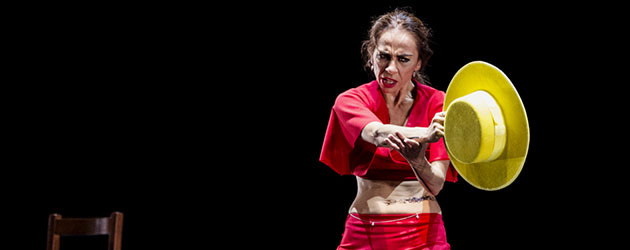Text: Sara Arguijo
Photos: Oscar Romero / La Bienal
Director and choreographer: Israel Galván. Apparatus: Pedro G. Romero. Dance: Isabel Bayón, Alicia Márquez, Nieves Casablanca. Guitar: Jesús Torres. Voice: David Lagos. Clavichord, organ: Alejandro Rojas-Marcos. Percussion: El Niño Murillo. La Bienal. Teatro de la Maestranza . September 26, 2016
Israel Galván awakens the monster in Seville
If at the entrance to the theater no one denied the extreme interest in seeing what Israel Galván had done with Isabel Bayón in «Dju-Dju», at the exit no one was able to conceal their displeasure. I remembered the times newcomers to the art would ask «is that supposed to be pretty?», or the first time I saw «Mulholland Drive», and I had to race home to internet in search of comments that would put Lynch's madness in order for me, but I was hooked all the same. In fact, there was a lot of that filmmaker in this grotesque show directed, for the first time, by the dancer.
To explain what went on at the Maestranza, let's go step by step. Flamenco content, zero. Dance, very little. In other words, compared to other Galván works, in which flamenco is present in the content of his dance and body, and completely removed from the universe Isabel Bayón had us accustomed to, a dancer who was so moving in the last Bienal with her «Caprichos del Tiempo», «Dju-Dju» is a contemporary theatrical work, tragicomic, burlesque, insane, conceptual and surreal that, without a doubt, is a difficult fit in the Bienal. And of course, the controversy and anger that could be sensed among the spectators, many of whom demanded to have their tickets refunded, while others enthusiastically demanded silence, and those who shouted out things like: «flamenco is dead!», «how about dancing a little, sweetie» and the more subtle «anyone who doesn't shout 'ole', may their mint leaves dry up», in reference to what is customarily shouted at the Falla theater during carnival. None of which was probably unforeseen by the performers.
The show, in a much-condensed description, is the story of superstition and fears that affect Isabel Bayón. A sort of shock treatment in which the dancer faced each fear head on from a typical list of bad omens and curses (stairways, mirrors, the spilling of salt, the color yellow, peteneras…), to come out completely freed. Or «Azalvajá», as she sings at the edge of the stage in one of the most enjoyable moments of her enormous dramatic output.
Between one thing and another, there was room for nearly everything. A robotic cat…white…who came and went, musicians dressed as angels, distorted voices, David Lagos singing siguiriyas wearing a mask depicting Munch's «Scream», the projection of «Superstición Andaluza» by Segundo Chomón, a guitarist who has the strings of his instrument cut, spotlights that fell down from above, reggaeton, dancing on wooden shoes, a Japanese lullaby and changes in the lighting leaving the audience in full illumination (with the associated stage fright).
And all wrapped up in a dizzying game of terror, humor and occasionally incoherent simultaneity, at times approaching genius, and seeming to endorse the basis of Grupo Pánico created in the 1960s by Fernando Arrabal, Alejandro Jodorowsky and Roland Topor. «The criticism of pure reason, the 'pan' explosion (as in 'everything'), the hymn to crazy talent, the anti movement, the rejection of 'seriousness', an ode to the lack of ambiguity…the art of life itself (which takes confusion and chance into consideration)…and quite the opposite», the playwright explained years later. An artistic expression that aims to announce controlled madness as a form of survival in a society in a crisis of values (post-modern society), as defended by the movement.
«Dju-Dju» is a provocative work that seeks to generate uneasiness and anxiety, to perturb, surprise and even assault by continuously moving between the extremes, and wrapping itself in a supposed aesthetic of «ugliness», with staging that transmitted the emptiness of Lars von Trier in «Dogville», an unsettling musical accompaniment in the style of Badalementi in «Twin Peaks», dreamlike wardrobe and landscapes inspired in Tim Burton, bizarre outbursts worthy of David Lynch and an introspective approach typical of Michael Haneke, to cite just a few contemporary cinematographic references that could be detected.
Best of all was the humor, and the capacity to generate confusion and keep the audience on its toes. The worst, the density of it all, unnecessary pieces that break the rhythm of the show and take you out of the mood and the story-line. Isabel Bayon, wonderful in her interpretation. Although it would have been nice to see her dance some more. This madness can also be narrated through her dancing.
